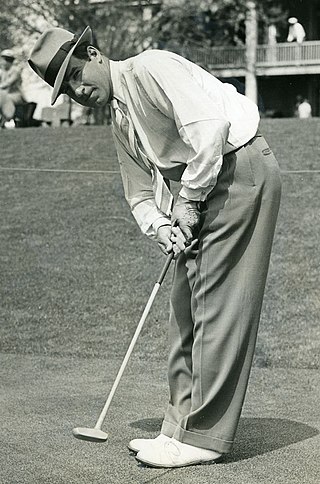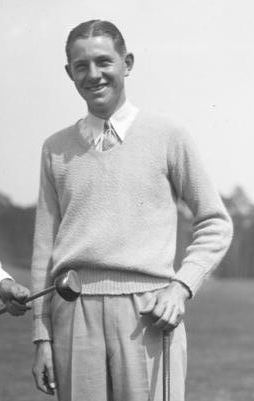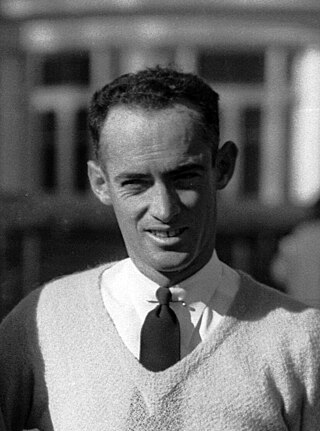
Samuel Jackson Snead was an American professional golfer who was one of the top players in the world for the better part of four decades and widely regarded as one of the greatest players of all time. Snead was awarded a record 94 gold medallions, for wins in PGA of America Tour events and later credited with winning a record 82 PGA Tour events tied with Tiger Woods, including seven majors. He never won the U.S. Open, though he was runner-up four times. Snead was inducted into the World Golf Hall of Fame in 1974.

Gene Sarazen was an American professional golfer, one of the world's top players in the 1920s and 1930s, and the winner of seven major championships. He is one of five players to win each of the four majors at least once, now known as the Career Grand Slam: U.S. Open , PGA Championship , The Open Championship (1932), and Masters Tournament (1935).

Henry Edward Cooper was an English-American PGA Tour golfer of the 1920s and 1930s. After he retired from competitive golf, he became a well-regarded instructor, into his 90s. In his long golf career he had 30 PGA Tour victories and was inducted into the World Golf Hall of Fame in 1992.

Leo Harvey Diegel was an American professional golfer of the 1920s and early 1930s. He captured consecutive PGA Championships, played on the first four Ryder Cup teams, and is a member of the World Golf Hall of Fame.

Olin A. Dutra was an American professional golfer who played on the PGA Tour in the 1920s and 1930s. He won two major titles, the PGA Championship in 1932 and the U.S. Open in 1934, and was the first major champion born in the western United States.

John Joseph Farrell was an American professional golfer, best known for winning the U.S. Open in 1928. Over the course of his career, he won 22 PGA Tour events. He was elected to the World Golf Hall of Fame in 2023 and will be inducted in 2024.

Horton Smith was an American professional golfer, best known as the winner of the first and third Masters Tournaments.

Herman Densmore "Denny" Shute was an American professional golfer who won three major championships in the 1930s.
Paul Scott Runyan was an American professional golfer. Among the world's best players in the mid-1930s, he won two PGA Championships, and is a member of the World Golf Hall of Fame. Runyan was also a golf instructor.
Southport and Ainsdale Golf Club is an 18-hole championship golf course in North West England, situated near the Merseyside towns of Southport and Ainsdale, north of Liverpool. The course is near the coast of the Irish Sea, set amongst ranges of tall sandhills and smaller sand dunes, just south of Royal Birkdale Golf Club.

Craig Ralph Wood was an American professional golfer in the 1930s and 1940s, the winner of 21 PGA Tour titles including two major championships and a member of three Ryder Cup teams (1931, 1933, 1935).

Henry Gilford Picard was an American professional golfer.

William Lawson Little Jr. was an American professional golfer who also had a distinguished amateur career.
David Douglas was an American professional golfer who played on the PGA Tour in the 1940s and 1950s.

Albert Andrew Watrous was an American professional golfer who played on the PGA Tour in the 1920s and 1930s.
The 6th Ryder Cup Matches were held 29–30 June 1937 at the Southport and Ainsdale Golf Club in Southport, England. The United States team won the competition by a score of 8 to 4 points. It was the first time that the host team lost the competition and the second of seven consecutive wins for the U.S. side. The course had hosted the event four years earlier in 1933, Britain's last win until 1957.
The 4th Ryder Cup Matches were held 26–27 June 1933 at the Southport and Ainsdale Golf Club in Southport, England. The Great Britain team won the competition by a score of 61⁄2–51⁄2 points, which at the time was the closest score possible other than a tie. As with the three previous events, the host team won and the series was tied at two wins each.
Charles Albert Whitcombe was an English golfer. He was born in Berrow, Burnham-on-Sea, Somerset, the second of the three Whitcombe brothers who were all successful English professional golfers in the 1920s and 1930s and – despite never winning The Open Championship like his younger brother Reg – could be considered the most prominent of the three, winning the British PGA Matchplay Championship twice and captaining the Ryder Cup side four times.
The Shawnee Open was a golf tournament that was first held in 1912. It was played at The Shawnee Inn & Golf Resort in Smithfield Township, Monroe County, Pennsylvania. The course was completed in 1911, the first design by renowned architect A. W. Tillinghast. The Shawnee Open was recognized as a PGA Tour event from 1916 to 1937. While no longer recognized as a PGA Tour event, there have been more than 60 Shawnee Opens played. It was sponsored by the Philadelphia section of the PGA of America.
Patrick Joseph Mahon was an Irish professional golfer. He was one of the leading Irish professionals of the 1930s and had one exceptional season, 1937, where he was runner-up in three important British tournaments, third in another, finished second in the Harry Vardon Trophy standings and won the Irish Professional Championship. He won the Western Isles Open Championship in 1935 and won the Irish Professional Championship again in 1938 and 1939.












